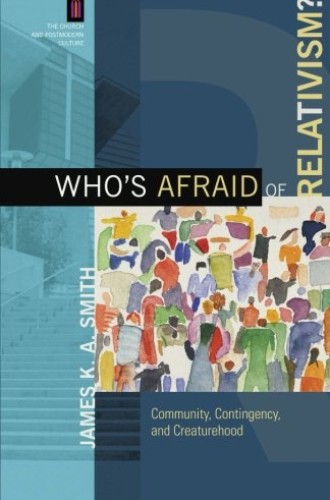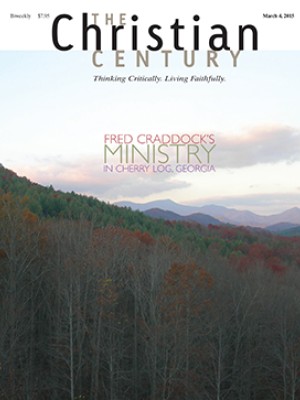Who’s Afraid of Relativism? by James K. A. Smith
James K. A. Smith is a philosophical theologian concerned about truth. In this simply structured and transparently argued book, he suggests that the work of Richard Rorty can be a source of renewal even though it makes many conservative Christians shrink in horror. Hating Rorty, on the other hand, reveals the shortcomings of people’s theological assumptions.
Smith perceives the preponderance of American Christians as people bent on security, comfort, and autonomy—functional deists and practical atheists whose vision is shaped by ideals of independence. Such ideals trigger a Promethean project of making themselves direct, rational, individual knowers whose status and knowledge cannot be subverted by unpredictable changes in circumstances. For such Christians, truth is equated with terms like absolute and objective, words that turn Christianity into a mechanism for achieving all-seeing impregnability. In order to preserve the power and privilege such a perspective is designed to secure, it’s necessary—at all costs—to hold on to representational notions of truth by which one’s interior impressions precisely mirror external reality.
Read our latest issue or browse back issues.
But once it’s acknowledged that Ludwig Wittgenstein was right and that language is a game that explains how rather than an arrow that identifies what, the whole edifice of solitary, independent knowing is in danger. If knowledge is control, then saying “it depends” is more or less the same as saying “it’s not true.” Hence the fusillade directed from conservative quarters at Rorty and his pragmatic companions.
As Smith acutely points out, this project is powerful and widespread—but it isn’t Christianity. What is Christianity? Christianity is a form of life in which the conditions of our knowledge are coincident with our status as material, contingent, finite, created social beings. Thus the pragmatism of Wittgenstein, Rorty, and Robert Brandom, far from undermining any aspiration to truth, offers guidelines about where that truth is to be found.
It turns out that Christianity is pretty much everything George Lindbeck said it was in his landmark work The Nature of Doctrine 30 years ago. God is not distant, independent, and absolute. And salvation is not about displacing God and becoming all-powerful beings ourselves. Instead, in the incarnation and crucifixion we see God in Christ, who enters our contingent existence. Human flourishing lies in interdependent communities where growing in faith is like learning a language and where life together is made up of practices of grace and worship.
This compelling thesis is especially electric because it was composed by a professor at Calvin College and is thus a critique written within, not just about, evangelical culture. The broad outline—that the conservative gospel has become one of individual escape rather than ecclesial solidarity—is, of course, very familiar. And the remedy—the cultural-linguistic model of Lindbeck—is not new.
Smith does not develop Lindbeck’s model beyond the broad terms its author offers. What’s remarkable about Smith’s book is that it takes a notorious enemy—relativism—and makes it a friend. This displays the right kind of confidence, a humble faith that’s not looking to make itself impervious to threats but that listens attentively to its critics and realizes that they have the key to its own renewal. In this sense Smith admirably practices exactly what he preaches.
The style of writing is that of a restless, energetic, infectious college teacher. Each philosopher discussed gets a chapter, and in each case one key book is identified and expounded on, with key phrases repeated often. Frequently the language spills over from the introductory to the advanced, exposing the difficulty of fulfilling the book’s modest and grand purposes simultaneously. The most enjoyable parts of the exposition are Smith’s absorbing narrations of films that illustrate and are made intriguing by the arguments of each philosopher. These accounts are beautifully done.
Two other agendas are playing out here. One is Smith’s larger project. He writes, “I hope this brief primer on pragmatism can be received as the philosophical springboard for understanding postliberalism, which is, in many ways, an embodiment of the religious and theological implications of pragmatism.” He imagines his book as “the long-lost prequel” to Lindbeck’s Nature of Doctrine, charting a philosophical path to Lindbeck’s theological commitments. Smith’s larger “cultural liturgies” project is concerned with exploring the hinterland of Lindbeck’s cultural-linguistic model and contrasting the character-forming significance of secular conscious and unconscious liturgies with that of Christian ones. Thus this book is an extended footnote to Smith’s larger vision.
The other agenda involves a rhetorical contest for the mainstream of postliberalism. Radical orthodoxy has consumed a lot of theological oxygen at conferences and among those pursuing doctoral studies in theology. Smith is making it clear that his notion of truth is different from that of some of truth’s fashionable advocates. Smith sees Platonic notions of truth—where there are “forms” of goodness, truth, and beauty that govern meaning—as rationality from above. By contrast, Smith sees his version of pragmatism as very much a form of rationality from below. Plato’s philosophy looks suspiciously like a different form of the same all-seeing impulse to know everything from a distance—the accusation Smith has against conservative, almost Gnostic, independent seers. In this sense what is latent in the book is the ancient tension between Plato and Aristotle, and Smith is upholding the Aristotelian flag and aligning it, as others have done, with both the philosophical school of Wittgenstein and the theological school of Karl Barth.
Reading Lindbeck’s Nature of Doctrine was a threshold moment for me. It didn’t cause a conversion; it gave me a structure and vocabulary for a transformation that had taken place in me over the previous two years. Smith’s book is aimed at students who are more evangelical, more moviegoing, more sophomoric (Smith’s word) than I was. But it could have the same effect on many. And in the process it makes a large step toward claiming Rorty as a fellow traveler for Christians open to a humble view of truth that emerges in community. It is no small achievement.







